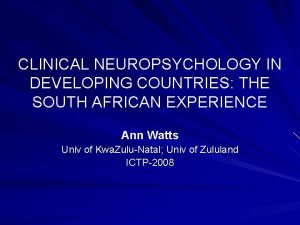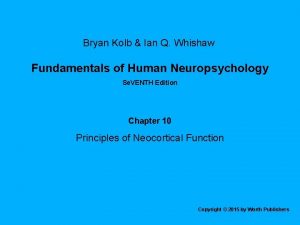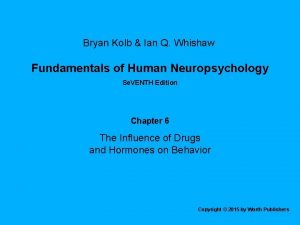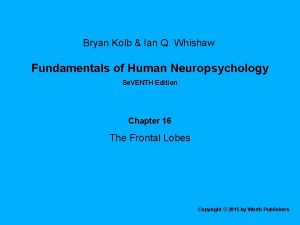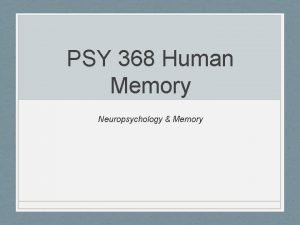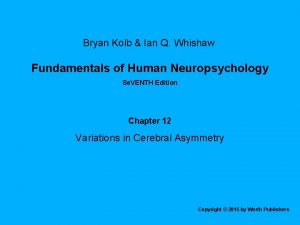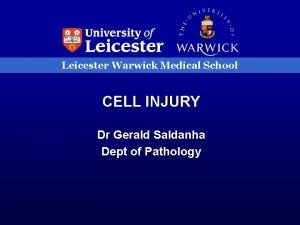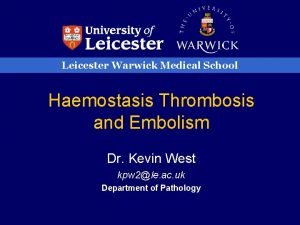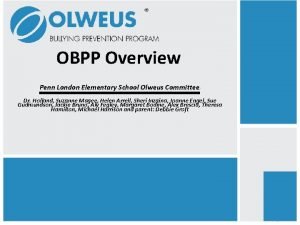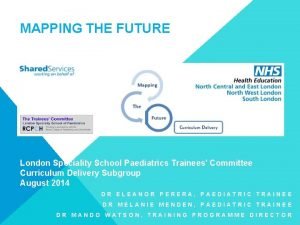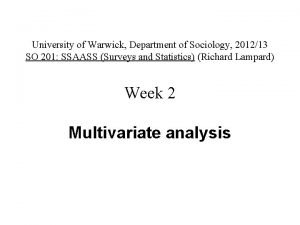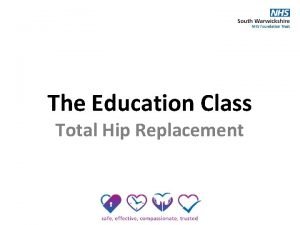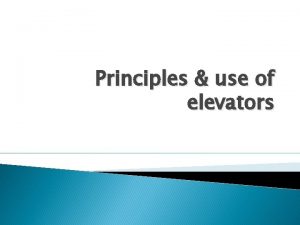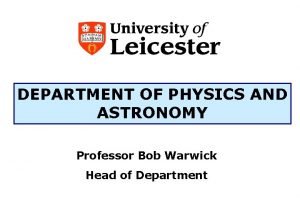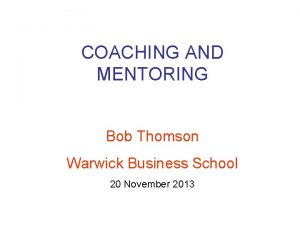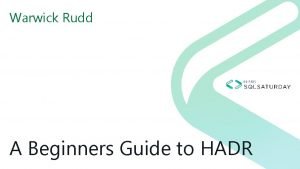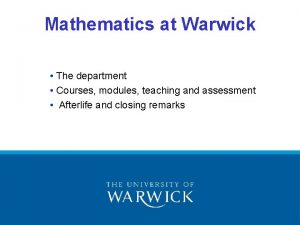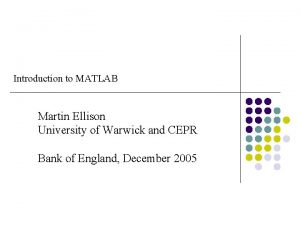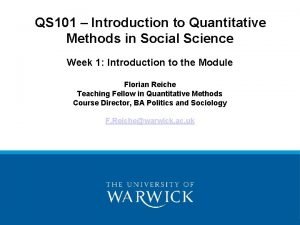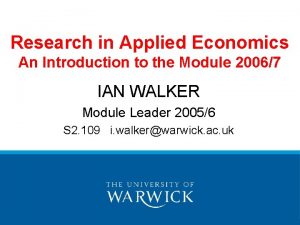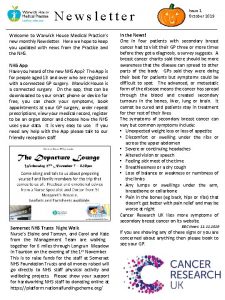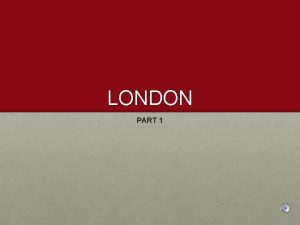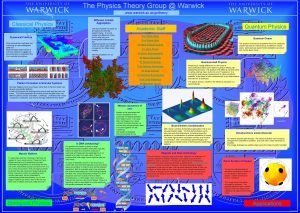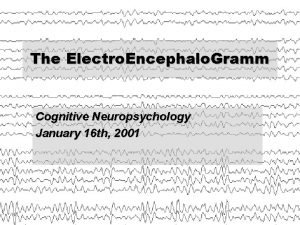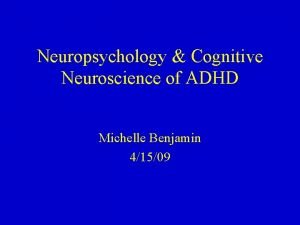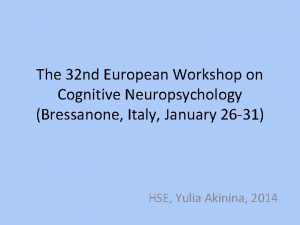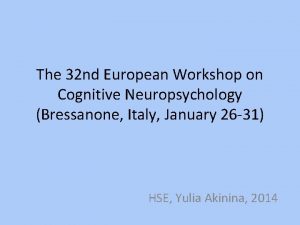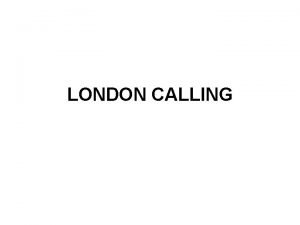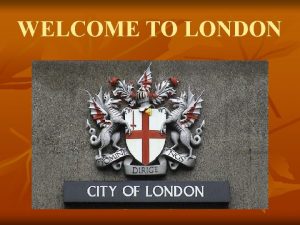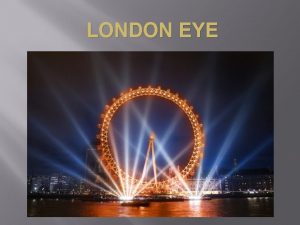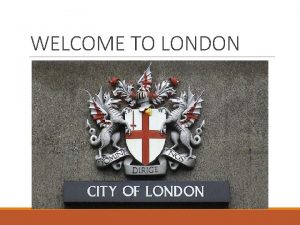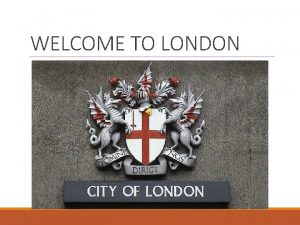Warwick in London Summer School Cognitive Neuropsychology Dr







































- Slides: 39

Warwick in London Summer School Cognitive Neuropsychology Dr. Gemma Gray g. gray@warwick. ac. uk

Learning Objectives - After today’s lecture, you will be able to: Give a brief overview of major neuroanatomy Explain what cognitive neuropsychology is Describe some famous case studies and what they have told us about the brain Describe what disorders of vision, action and speech tell us about normal brain function

Introduction to the brain What is cognitive neuropsychology? Case studies and what they tell us

The Brain Squishy! Corpus callosum Cerebral Cortex: outer layer of the brain Convoluted: Gyri – ridges, Sulci – grooves Two hemisphere joined by the corpus callosum Gyri Sulci

The Brain Each hemisphere has 4 lobes – Frontal Lobe: planning, decision making – Parietal Lobe: somatosensory functioning – Temporal Lobe: Hearing, memory – Occipital Lobe: vision Cerebellum: Balance and coordination

The Brain Contralateral control: Each hemisphere controls the opposite side - vision, attention, action

Brain imaging Electroencepholography (EEG) Positron Emission Topography (PET)

Brain imaging Magnetic Resonance Imaging (MRI) Functional Magnetic Resonance Imaging (f. MRI) Transcranial Magnetic Stimulation (TMS) https: //www. youtube. com/watch? v=i. SOf. P 5 w_AHY

What is cognitive neuropsychology?

What is cognitive neuropsychology? Study of cognitive impairments following brain injury Looks at individual cases to determine what processes have been disrupted Develop understanding of normal cognitive processing

What is Cognitive Neuropsychology Looks at case studies of patients with brain lesions Uses this information to understand normal cognitive ability Uses a variety of neuropsychological tests to understand the patients impairment

Associations and Dissociations Control Test Performance Associations: clusters of abilities or tasks that patients can’t do Conclude that damaged area of the brain is involved in both tasks Patient A Speech Task A Reading Task B

Dissociation: a patient who is impaired at one task but normal at another Double dissociation: 2+ patients with opposing deficits Conclude that two functions involve separable processes Test Performance Associations and Dissociations Patient B Patient A Speech Memory

Modularity By looking at what mental processes are disrupted by brain injury We can make some conclusions about normal functioning

Single Case Studies Looking at the abilities of single patients with brain injury Compared to abilities of age matched controls BUT individual differences between patients

Assessment Cognitive assessment: a range of tests designed to assess normal etc. More specific tests used to determine more specific cognitive problems, i. e. where in the processes problems lie.

Single case studies and what they tell us about the brain

Famous cases Phineas Gage Railway worker who had an accident Accident caused a metal rod to pierce his brain (orbitofrontal areas, Damasio et al. , 1994) Massive personality change following accident

Conclusions Frontal lobes are involved in… – Personality: “vulgar… intolerable to decent people” – Inhibition: “impatient of restraint or advice when it conflicts his desires” – Planning: Abandoning “future plans for others that appear more feasible”

HM (Scoville and Milner, 1957) Parts of temporal lobe and hippocampus removed to control seizures Following surgery: – Retrograde amnesia: remembering past events – Antegrade amnesia: learning new information

HM (Milner, 1962) Mirror drawing task: assesses motor learning Normal mirror drawing performance: Intact procedural memory

Clive Wearing www. youtube. com/watch? v=Vwigmktix 2 Y

Conclusions Hippocampus and temporal lobe important forming memories Dissociation between different memory systems: STM, LTM and procedural knowledge HM and Clive Wearing: Problem with memory consolidation – transferring information from STM to LTM

HJA Stroke resulting in occipital lobe damage Resulted in visual problems Unable to recognise objects – visual agnosia ‘I have not the glimmerings of an idea. The bottom point seems solid and the other bits are feathery. It does not seem logical unless it is some sort of brush’ Humphreys and Riddoch (1987)

Conclusions Impaired at recognising range of objects Intact ability to copy pictures, to draw from memory and recognise objects from other modalities HJAs problem is in perceiving the whole object

Summary Cognitive neuropsychology involves studying how the abilities of people with brain injury differ from people without brain injury Case studies of patients with damage to different regions of the brain have informed much of our theories about normal behaviour

Spatial Neglect

Spatial Neglect Spatial attention disorder: Fail to notice things in one side of space Following injury to the parietal lobe and temporoparietal junction (usually RH) Observable in different aspects of their daily life – https: //www. youtube. com/watch? v=d 4 Fh. Zs-m 7 h. A

Assessment of Spatial Neglect Drawing and copying tasks Bisection and cancelation tasks

Is neglect person centred, object -centred, space centred…? Varies according to the patient Object centred or space-centred? Ogden scene copying task

Is neglect person centred, object-centred, space centred…? Varies according to the patient Object centred vs. spacecentred Near Space vs. far space: Halligan and Marshall, 1991; Vuilleumier et al, 1998 Personal vs peripersonal space

Does neglect occur in imagination? Varies according to the patient Representational Neglect: Bisiach and Luzzatti (1978)

Speech Disorders: Aphasia

Aphasia Inability to comprehend or produce speech Broca (1861) Patient Tan: Broca’s aphasia (Expressive Aphasia) Can understand speech, but have trouble producing speech Wernicke (1874) Wernickes’s aphasia (Receptive Aphasia) Can produce speech but have trouble understanding speech

Goodglass (1983) Cookie theft task

Videos of Brocas and Wernickes aphasia www. youtube. com/watch? v=3 oef 68 Yab. D 0 Broca’s aphasia https: //www. youtube. com/watch? v=JWCc. VQm. Em. Y&t=84 s

What does aphasia tell us about speech and language? Different parts of the brain are involved in speech production and speech comprehension Distinction between Broca’s and Wernicke’s aphasia too simplistic Other brain areas involved

Summary Cognitive neuropsychological assessment allows us to determine exactly where in a process a patient is impaired By studying patients with brain injury we can determine how the brain normal processes information Disorders such as neglect and aphasia have been investigated thoroughly to inform our understanding of language and attention

Further Reading Gazzaniga, M. S. (2018) Psychological Sciences – Chapter 3: Biology and Behaviour (Sections 3. 2 and 3. 4)
 Posterior language area
Posterior language area Neuropsychology in south africa
Neuropsychology in south africa Fundamentals of human neuropsychology
Fundamentals of human neuropsychology Fundamentals of human neuropsychology
Fundamentals of human neuropsychology Fundamentals of human neuropsychology
Fundamentals of human neuropsychology Hm study
Hm study Kolb whishaw fundamentals of human neuropsychology
Kolb whishaw fundamentals of human neuropsychology Cognitive and non cognitive religious language
Cognitive and non cognitive religious language Leicester warwick medical school
Leicester warwick medical school Leicester warwick medical school
Leicester warwick medical school Necrosis
Necrosis Leicester warwick medical school
Leicester warwick medical school Leicester warwick medical school
Leicester warwick medical school Summer school lodi unified
Summer school lodi unified Crescenta valley high school summer school
Crescenta valley high school summer school Assignment in spanish
Assignment in spanish Specialist maths school
Specialist maths school Penn london elementary school
Penn london elementary school London school of paediatrics
London school of paediatrics Warwick sociology modules
Warwick sociology modules 01926 600036
01926 600036 Crane pick elevator uses
Crane pick elevator uses The warwick model
The warwick model Edman tsang
Edman tsang Warwick physics department
Warwick physics department Kerry pinny
Kerry pinny Warwick mentoring scheme
Warwick mentoring scheme Susan carruthers warwick
Susan carruthers warwick Warwick dba
Warwick dba Warwick bartlett
Warwick bartlett Warwick maths modules
Warwick maths modules Warwick bartlett
Warwick bartlett Warwick matlab
Warwick matlab Florian reiche warwick
Florian reiche warwick Warwick evision
Warwick evision Warwick library catalogue
Warwick library catalogue Warwick castle virtual tour
Warwick castle virtual tour Ec331 warwick
Ec331 warwick Warwick house taunton
Warwick house taunton Matthew gibson warwick
Matthew gibson warwick

